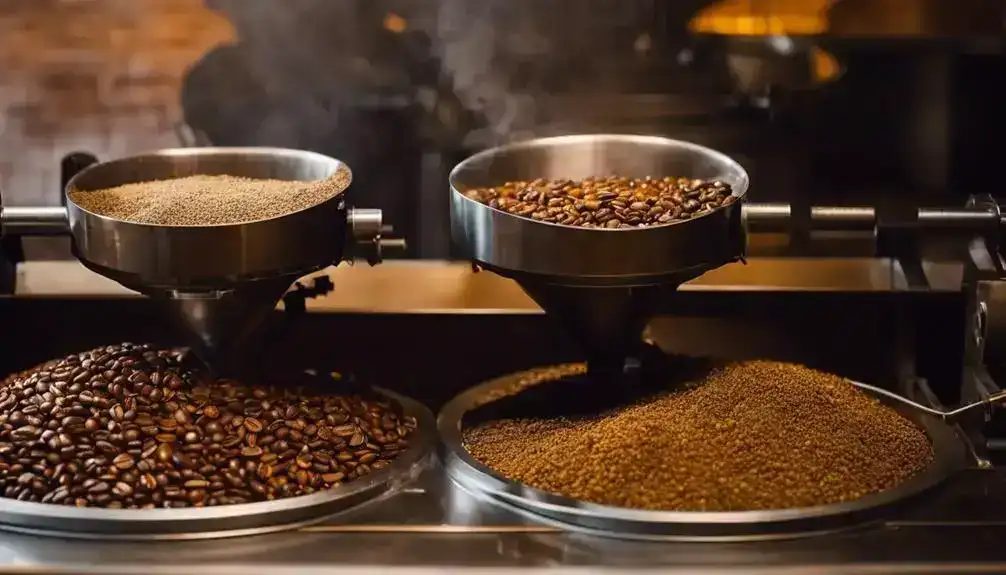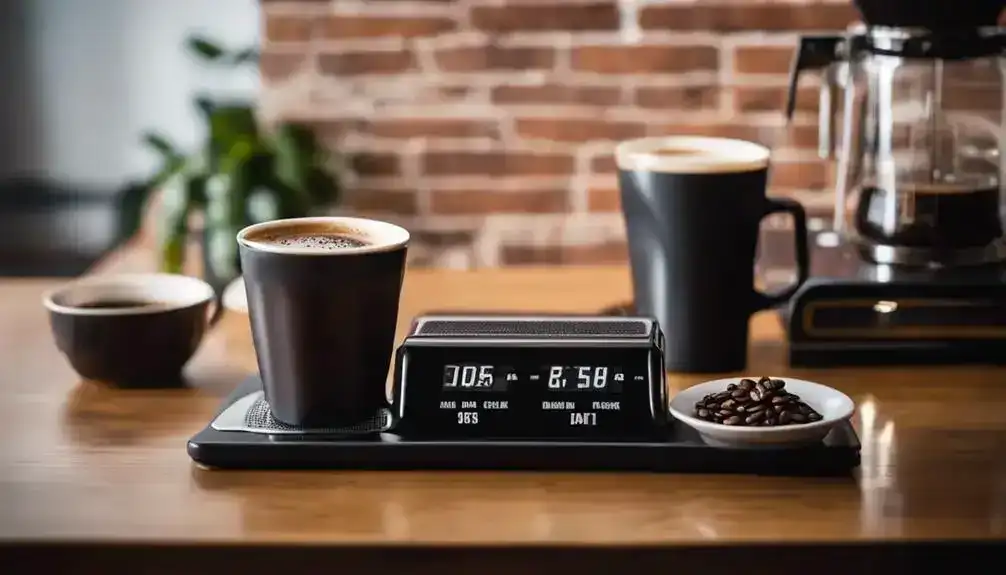Light roast coffee contains more caffeine per scoop than dark roast coffee because of the denser beans. This difference in bean density affects the amount of caffeine that can be extracted during brewing. Understanding this can help you choose your coffee based on your caffeine preferences.
If you want to know more about how the roast levels impact caffeine content, consider exploring how testing methods, roasting temperatures, and flavor profiles play a role. Each aspect adds to the broader understanding of caffeine levels in your favorite cup of joe.
Which Coffee Roast Has More Caffeine: Light or Dark?

When comparing caffeine levels in light and dark roast coffee, two key factors come into play: measuring by volume and measuring by weight. Here’s what you need to know:
- Measuring Caffeine by Volume: Light roast coffee typically has more caffeine when measured by volume due to the denser nature of the beans.
- Measuring Caffeine by Weight: On the other hand, when measured by weight, the caffeine content in light and dark roast coffee is nearly equivalent.
- Consider Both Methods: Understanding these measurement nuances can help you make informed choices about your caffeine intake based on how you prefer to measure your coffee.
Measuring Caffeine by Volume
In comparing light roast and dark roast coffee for caffeine content when measured by volume, the denser and heavier beans of light roast coffee generally result in higher caffeine levels per scoop.
This difference in caffeine concentration is especially noticeable when using brewing techniques that involve measuring coffee by volume rather than weight.
When brewing coffee by volume, the compact nature of light roast beans allows for more caffeine to be extracted per scoop compared to the larger and lighter dark roast beans.
Hence, if you prefer a stronger caffeine kick in your cup of coffee, Opting for light roast coffee and measuring it by volume could be the way to go.
Measuring Caffeine by Weight
Light roast coffee and dark roast coffee have nearly identical caffeine content when measured by weight due to their similar caffeine concentrations per gram. Measuring accuracy is important in determining the actual caffeine levels in your brew.
When using brewing techniques that involve weighing coffee grounds, such as pour-over or French press, you guarantee a consistent caffeine intake regardless of the roast level.
Bean Density and Weight Differences in Coffee Roasts

When exploring the bean density and weight variances in coffee roasts, it’s important to understand the distinct characteristics of light and dark roast beans. Here’s a breakdown to take into account:
- Characteristics of Light Roast Beans: Light roast beans are denser and retain more water, resulting in a heavier and smaller bean structure.
- Characteristics of Dark Roast Beans: Dark roast beans, on the other hand, are less dense and lighter due to water loss during the roasting process, leading to puffier beans.
- Understanding these differences sheds light on how bean density and weight can impact the overall coffee experience and caffeine content.
Characteristics of Light Roast Beans
Considering the bean density and weight differences between light and dark roast coffee, the characteristics of light roast beans impact their caffeine content and physical properties.
Light roast beans are denser due to retaining more water during the roasting process, resulting in a heavier bean compared to dark roast beans. This higher density affects the caffeine content when measured by volume, making light roast coffee appear to have more caffeine.
Additionally, the Flavor profiles of light roast beans are distinct, known for their bright, acidic, and complex flavors. These characteristics contribute to the perceived invigorating quality of light roast coffee, despite having similar caffeine levels to dark roast.
Understanding these differences can help you choose the right coffee roast based on your preferences.
Characteristics of Dark Roast Beans
Dark roast beans exhibit distinct characteristics compared to light roast beans, due to their lower density and lighter weight resulting from water loss during roasting. These beans are roasted for a longer period, at higher temperatures, causing more moisture to evaporate and the beans to expand. This process results in a puffier appearance and a less dense structure compared to light roast beans.
The lighter weight of dark roast beans can impact brewing methods, as they may require a coarser grind to achieve the best extraction. Understanding these differences in bean density and weight is essential for selecting the right roast for your preferred brewing techniques, ensuring a flavorful and well-balanced cup of coffee.
How Does Testing Methodology Affect caffeine levels in coffee?

When exploring how testing methodology impacts caffeine levels in coffee, it becomes evident that the way you measure can influence the results you obtain.
To better understand this concept, consider the following points:
- Caffeine Tests by Volume: Testing equal volumes of light and dark roast coffee often showcases the higher caffeine content in light roasts due to their denser beans.
- Caffeine Tests by Weight: When measuring equal weights of light and dark roast coffee, the caffeine content appears nearly identical because both roasts contain comparable amounts of caffeine per gram.
Caffeine Tests by Volume
Using a consistent testing methodology for caffeine levels in coffee, measuring by volume reveals that light roast coffee often contains more caffeine due to the denser nature of the beans.
When comparing caffeine concentration in light and dark roasts by volume, the denser light roast beans result in a higher caffeine content per scoop. This method accounts for the physical space occupied by the beans, allowing a more accurate representation of caffeine levels.
Volume measurements provide valuable insights into the caffeine content of different coffee roasts, offering a practical approach for understanding the variations in caffeine concentration.
Caffeine Tests by Weight
During caffeine testing in coffee, measuring by weight provides a more accurate assessment of caffeine levels, allowing for a precise comparison between light and dark roast varieties.
When coffee is measured by weight, the brewing methods also play an essential role in caffeine extraction. Different brewing techniques can affect how much caffeine is extracted from the beans, influencing the final caffeine content in your cup.
Is Caffeine Stable During Coffee Roasting?

Caffeine in coffee remains relatively stable during the roasting process, with minimal degradation occurring despite some debate on the topic.
Studies generally indicate that caffeine isn’t markedly affected by the temperatures typically used in roasting, staying intact throughout the process.
While there are discussions about minor caffeine degradation at high temperatures, the consensus is that any changes in caffeine content are minimal and don’t have a substantial impact on the overall caffeine levels in coffee.
Caffeine Stability at High Roasting Temperatures
Stability of caffeine during the roasting process in coffee remains a subject of ongoing debate among researchers and industry experts. When contemplating caffeine degradation during roasting, it’s essential to comprehend the impact of roasting temperatures on the stability of this essential compound.
Here are three key points to bear in mind:
- Effect of High Temperatures: Roasting temperatures typically don’t exceed 470°F, which is well below the threshold for notable caffeine degradation.
- Minimal Caffeine Degradation: While some studies suggest minor caffeine degradation at high temperatures, the consensus is that any impact is minimal and unlikely to alter the caffeine content of the coffee significantly.
- Overall Stability: Caffeine is generally stable during the roasting process, ensuring that your cup of coffee retains its caffeine kick.
Debates on Caffeine Degradation During Roasting
The ongoing discussions surrounding the degradation of caffeine during the roasting process in coffee highlight differing viewpoints on the potential impact of high temperatures on this essential compound.
Key Points:
- Roasting temperature debate: Some studies suggest minor caffeine degradation at high temperatures.
- Caffeine oxidation concerns: Most agree that the effect is minimal and doesn’t alter caffeine content to a considerable extent.
- Effects of high temperatures: Caffeine remains relatively stable during the coffee roasting process, with minimal degradation concerns at typical roasting temperatures.
Understanding the nuances of caffeine stability during roasting is essential for coffee enthusiasts seeking to preserve the integrity of this stimulating compound.
While minor changes may occur, the overall caffeine content in your favorite brew is likely to remain consistent despite the heat of the roasting process.
Practical Tips for Measuring Coffee Caffeine Content

When it comes to measuring coffee caffeine content, there are practical tips to guarantee consistency in your daily intake. Here are three key points to keep in mind:
- Use a kitchen scale: Measuring coffee by weight provides a more accurate representation of caffeine content.
- Consistent intake: Weighing coffee grounds ensures that you maintain a steady caffeine level, regardless of the roast type.
- Kitchen scale advantages: Using a kitchen scale over volume measurements helps in achieving precise caffeine levels in your brewed coffee.
Ensuring Consistent Caffeine Intake
For consistent caffeine intake, opt for weighing your coffee grounds instead of relying on volume measurements.
Measuring coffee by weight guarantees accuracy in caffeine content regardless of the roast level. This method takes into account the density differences between light and dark roasts, providing a more reliable way to monitor your caffeine intake.
Brewing methods can also impact the caffeine consistency in your coffee, so Using a kitchen scale for precise measurements is essential.
By prioritizing measuring accuracy through weight rather than volume, you can better control your caffeine consumption and tailor your coffee experience to meet your desired caffeine levels.
Make this small change to your routine for a more consistent and customized caffeine intake.
Best Practices for Home Coffee Brewing
To guarantee precision in measuring caffeine content in your home-brewed coffee, utilizing a kitchen scale for accurate weight measurements of coffee grounds is crucial.
When measuring coffee by weight, you establish a consistent caffeine intake regardless of the roast level. This method accounts for the density variations between light and dark roasts, providing an accurate representation of the caffeine content in your brew.
By using a kitchen scale, you can follow brewing techniques more effectively, adjusting the amount of coffee grounds to suit your flavor preferences while maintaining a reliable caffeine level.
This practice allows you to enjoy your coffee just the way you like it, knowing you have control over both the taste and caffeine content of your daily brew.
How Do Flavor Profiles Affect Caffeine Perception in Coffee?

The distinct flavor profiles of light and dark roast coffee can influence how you perceive the strength of caffeine in your cup. Light roast coffee, known for its bright and acidic flavors, might give you the impression of being more invigorating, even though its caffeine content is similar to that of dark roast.
On the other hand, dark roast coffee with its bold and robust flavors may convey a sense of strength without necessarily containing higher levels of caffeine.
Flavor Profile of Light Roast Coffee
Considering the flavor profile of light roast coffee, its bright, acidic, and complex notes can influence how caffeine is perceived in your cup.
- Acidity: Light roast coffee tends to have a higher acidity level compared to dark roast, which can give the perception of a stronger flavor that may enhance the sensation of caffeine kick.
- Brightness: The vibrant and lively flavors in light roast coffee can create a more invigorating experience, potentially making the caffeine effect feel more pronounced.
- Complexity: Light roast coffee often showcases a wide range of nuanced flavors, which can engage your taste buds and create a sensory experience that might amplify the perceived caffeine potency.
Flavor Profile of Dark Roast Coffee
Dark roast coffee, with its bold and robust flavor profile characterized by notes of chocolate and caramel, can influence how the perception of caffeine strength is experienced.
Three factors affecting caffeine perception in dark roast coffee are:
- Intensity of Flavors: The strong and bold flavors in dark roast coffee can give an impression of heightened caffeine content, even though the actual caffeine levels are similar to lighter roasts.
- Richness of Aroma: The rich aromas of dark roast coffee, often associated with deep caramelization and smokiness, can create a sensory experience that tricks the mind into perceiving a stronger caffeine kick.
- Complexity of Taste: The intricate flavor profile of dark roast coffee, with its bitter-sweet tones and deep richness, can contribute to a perceived increase in caffeine potency, enhancing the overall coffee-drinking experience.
health benefits of Light vs. Dark Roast Coffee

Light roast and dark roast coffees both offer health benefits through their unique nutritional profiles. Light roast coffee tends to retain more original nutrients and antioxidants, while dark roast coffee may provide a higher concentration of certain bioactive compounds due to the roasting process.
Both roasts contain antioxidants and bioactive compounds that contribute to various health benefits, such as reducing inflammation and improving heart health.
Nutritional Differences in Coffee Roasts
Nutritional variances between light and dark roast coffee can impact the health benefits associated with each roast level. When comparing light and dark roast coffee, consider the following:
- Nutrient Retention: Light roast coffee may retain more original nutrients due to its shorter roasting time, preserving antioxidants and vitamins that could be lost during prolonged roasting.
- Bioactive Compounds Concentration: Dark roast coffee offers a higher concentration of certain bioactive compounds like melanoidins, which are formed during the roasting process and may have potential health benefits.
- Antioxidant Levels: Light roast coffee tends to have higher antioxidant levels, which are beneficial for reducing inflammation and supporting overall well-being.
Understanding these differences can help you choose the coffee roast that aligns best with your health goals.
Antioxidants and Bioactive Compounds in Coffee
When evaluating light vs. dark roast coffee, here are three key factors worth examining:
- Brewing Methods: The choice of brewing method can influence the extraction of antioxidants and bioactive compounds from coffee grounds, impacting the final health benefits of your cup.
- Roasting Techniques: Different roasting techniques can alter the concentration of antioxidants in coffee beans, with lighter roasts generally preserving more of these beneficial compounds compared to darker roasts.
- Health Benefits: Both light and dark roasts contain antioxidants and bioactive compounds that contribute to various health benefits, such as reducing inflammation and improving heart health.
Experimenting with brewing methods and roasting techniques can help you maximize the health benefits of your coffee.
How Do Coffee Bean Varietals Impact Caffeine Content?

When considering the impact of coffee bean varietals on caffeine content, it’s important to note that Robusta beans contain nearly twice as much caffeine as Arabica beans. This difference in caffeine levels between the two bean types can greatly affect the overall caffeine content of your coffee blend. Understanding the caffeine content of different bean varietals is vital for those seeking a particular caffeine strength in their coffee.
| Bean Type | Caffeine Content (%) |
|---|---|
| Arabica | 1.2 |
| Robusta | 2.2 |
Comparing Caffeine in Arabica and Robusta Beans
Robusta beans contain approximately 2.2% caffeine, making them a higher-caffeine option compared to Arabica beans, which typically have around 1.2% caffeine content. This notable difference in caffeine levels between the two bean varieties directly impacts the overall caffeine content of the coffee.
When comparing Arabica and Robusta beans regarding caffeine, it’s essential to take into account how the choice of bean varietal can affect your caffeine intake. If you prefer a stronger kick from your coffee, opting for Robusta beans may be the way to go. On the other hand, if you enjoy a milder caffeine experience, sticking with Arabica beans might suit your preference better.
The choice between these two bean varietals can significantly influence your coffee’s caffeine content and overall flavor profile.
Impact of Bean Blends on Caffeine Levels
The choice of coffee blends that include Robusta beans can greatly impact the caffeine levels in your brewed coffee, especially when considering the influence of different bean varietals on caffeine content.
Robusta beans contain nearly twice as much caffeine as Arabica beans, making them a popular choice for those seeking a stronger caffeine kick. When blended with other beans, Robusta can elevate the overall caffeine content of the coffee, particularly in dark roasts where the beans are measured by weight.
This impact of caffeine blends on your coffee not only affects the energy boost you receive but also plays a role in the flavor preferences you may have. Experimenting with different bean blends can help you find the perfect balance between caffeine strength and taste.
Conclusion
So, next time you reach for your morning cup of joe, remember that the caffeine content can vary depending on the roast. Whether you prefer the bright and lively flavors of a light roast or the bold and intense notes of a dark roast, knowing the caffeine levels can help you make an informed choice.
Picture yourself savoring that perfect cup of coffee, knowing that you’ve chosen the roast that suits your caffeine needs best.

